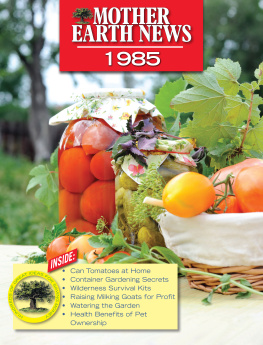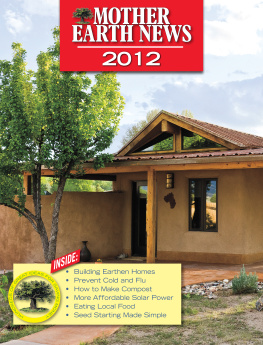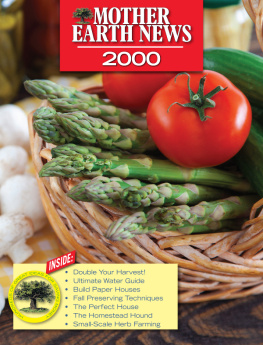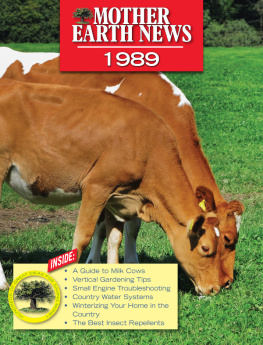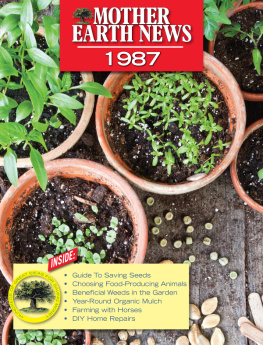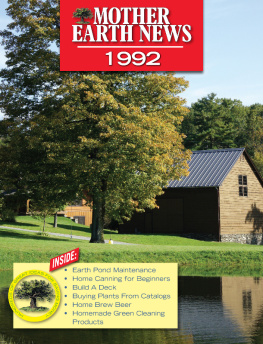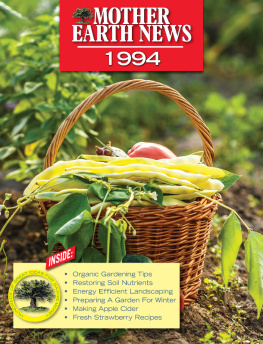Mother Earth News 1985
Here you can read online Mother Earth News 1985 full text of the book (entire story) in english for free. Download pdf and epub, get meaning, cover and reviews about this ebook. year: 1985, publisher: Mother Earth News, genre: Science / Home and family. Description of the work, (preface) as well as reviews are available. Best literature library LitArk.com created for fans of good reading and offers a wide selection of genres:
Romance novel
Science fiction
Adventure
Detective
Science
History
Home and family
Prose
Art
Politics
Computer
Non-fiction
Religion
Business
Children
Humor
Choose a favorite category and find really read worthwhile books. Enjoy immersion in the world of imagination, feel the emotions of the characters or learn something new for yourself, make an fascinating discovery.
- Book:Mother Earth News 1985
- Author:
- Publisher:Mother Earth News
- Genre:
- Year:1985
- Rating:4 / 5
- Favourites:Add to favourites
- Your mark:
- 80
- 1
- 2
- 3
- 4
- 5
Mother Earth News 1985: summary, description and annotation
We offer to read an annotation, description, summary or preface (depends on what the author of the book "Mother Earth News 1985" wrote himself). If you haven't found the necessary information about the book — write in the comments, we will try to find it.
Unknown: author's other books
Who wrote Mother Earth News 1985? Find out the surname, the name of the author of the book and a list of all author's works by series.
Mother Earth News 1985 — read online for free the complete book (whole text) full work
Below is the text of the book, divided by pages. System saving the place of the last page read, allows you to conveniently read the book "Mother Earth News 1985" online for free, without having to search again every time where you left off. Put a bookmark, and you can go to the page where you finished reading at any time.
Font size:
Interval:
Bookmark:

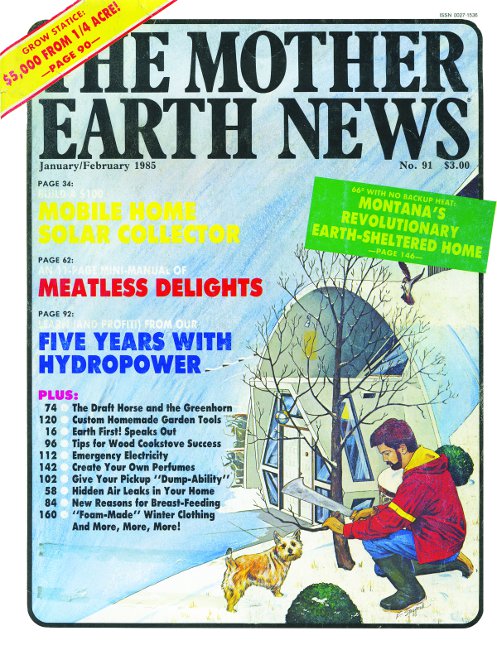
Leather aficionados who want to keep their prized boots, bags, shoes, belts, chairs, harnesses and saddles in top condition need saddle soap. Not only does it clean away dirt and grit that dull leathers luster, but it also supplies the oils and waxes essential for long-lasting suppleness and protection.
To make inexpensive saddle soap at home, youll need two pots (one of stainless steel or heat-resistant glass), a stainless steel spoon, short, wide-mouthed jars or empty commercial saddle soap containers, beeswax, pure flake lye, castile soap shavings, water and pure gum turpentine. (Beeswax and pure flake lye can be found at a hardware, candle, or grocery store.)
In the steel or tempered-glass pot, combine 6 parts beeswax, 10 parts pure flake lye and 10 parts water. Caution: Pure flake lye can burn and corrode skin, clothes and furniture, so be careful! Boil this mixture for five minutes, stirring constantly with the stainless steel spoon.
Next, in the second pot, melt 2 parts castile soap shavings with 10 parts water, mixing them with the well-rinsed spoon. When the soap liquefies, add it slowly to the lye-and-beeswax mixture, blending evenly until fully combined.
Next, remove the pot from any heat and stir in 15 parts of turpentine. (Watch out: Turpentine is highly flammable.) Pour immediately into containers; cover and keep in a cool, dry place. The soap can be kept indefinitely.
If you prepare the recipe with one part equaling one tablespoon, youll have enough to fill four 8-ounce jars.
When you use the saddle soap, have two soft flannel cloths on hand. Soak and wring out one until almost dry, dip it into the soap, and rub the leather with a firm circular motion. Rinse that cloth in warm water, wring out, and then use it to remove any excess lather. Use the second dry cloth to polish the leather to a soft luster, and say goodbye to ugly-looking leather goods!
ILLUSTRATION: MOTHER EARTH NEWS EDITORS
Saddle soap helps keep leather goods such as bags, shoes and saddles in good condition.
In our pan of northern California, maintaining a high level of food self-sufficiency isnt just practical - its all but necessary! We live in the Mendocino National Forest region, and - though this may come as a surprise to people whove never visited the upper portion of the Golden State - from November through May, the road from our ranch to town is often impassable. (Our mountainous, 4,000-degree-day area has quite a variable climate. Although it rarely gets below 16 degrees Fahrenheit, it can also snow in June!)
Therefore, weve learned to rely on homegrown food during the winter months. Much of our cold-weather stockpile consists of stored produce from our summer garden; but not long ago, in search of more culinary variety and vitamins, we decided to build the low-cost greenhouse pictured in the image gallery. Its performance as a producer of fresh winter foods has surprised even us, and theres no reason why anyone with a suitable south-facing piece of soil cant duplicate our do-it-yourself greenhouse.
If money is no object, I suppose a person could spend just about any amount of cash on a contractor-built greenhouse. However, not only were we determined to grow our own winter vegetables, but we aimed to do so without generating start-up costs that would effectively have us paying triple the store-bought price for our homegrown produce for years to come.
First of all, we arranged with the U.S. Forest Service to purchase a number of knob-cone pines growing on a ridge near our home. The price was right (low!), and pole-building construction is both effective and easy to learn. We glazed the structure with sheet plastic and simply worked the soil within the greenhouse to avoid having to build expensive and complicated growing beds. Finally, the greenhouse doesnt cost a thing to operate (other than what we spend to fertilize and water the plants), because it uses only the suns energy for heat, right on through the clouds and snow of winter.
In order to get that kind of efficiency from an essentially crude structure, we had to do a good bit of planning before we set to work. The angle of the roof was calculated to allow the maximum transmission of light (see Fig. 1 in the image gallery), and we chose a site on a south-facing slope, where the greenhouse would effectively receive more energy per unit of area than it would on level ground (Fig. 2).
Before actually beginning construction, we carried the poles (which had been stripped and allowed to cure), as well as all of the rest of our materials, to the site by hand and wheelbarrow, to eliminate the risk of erosion due to soil disturbance on the slope. The poles, of course, tapered from one end to the other. We used the thicker portions (they averaged about 6 inches in diameter) for the load-bearing parts of the structure and the thinner ends to frame up the doors and windows. Fig. 3 details the sizes of poles and nails used in each application.
We marked out the rough dimensions of the greenhouse on the site, making each side (shown as AB, BD, CD, and AC in Fig. 3) 13 feet long. The corner poles were each 6-inch-diameter posts cut to a length of 5 feet and set 1 foot 6 inches into the earth (with the help of a post-hole digger). Then, to provide support for the ridgepole, we cut two more 6-inch-diameter poles (E and F) 9 feet 6 inches long and set them each 1 foot 6 inches into the ground at a point 5 feet 3 inches down from the corresponding upper corner post. (Unless otherwise specified, all of the distances given are from center to center.) Next, a 4-inch-diameter timber (G), cut to about 9 feet in length, was sunk in place at a point 5 feet 3 inches up from the east bottom corner, leaving a 2 foot space (between it and F) for the doorway.
Next we cut two 15-foot poles of about 4-inch-diameter (H and I) and - after cutting the notches that would later receive the roof diagonals - secured them to their respective pairs of corner posts, allowing a 1-foot overhang on each end, as shown in Fig. 4. The 4-inch-diameter ridgepole (J) was then cut, notched and fitted in the same manner.
Once the three horizontal components were in place, it was time to measure the diagonals (K, L, M, and N) from the ridgepole to each of the four corner posts. We then cut the poles, making each slightly longer than the actual measurements dictated (better to trim later than to waste a too short pole), raised them into position, marked the exact contact points, then cut the ends, each at an angle, as shown in Fig. 4. Before nailing the diagonal poles, we also marked frame post G, then cut it off and notched it to accept the diagonal post L. With the preparations out of the way, K, L, M, and N were fastened in place. The horizontal poles O on the west and P and Q on the east were measured in a similar manner, then the vertical poles E, F, and G were notched to receive them.
Font size:
Interval:
Bookmark:
Similar books «Mother Earth News 1985»
Look at similar books to Mother Earth News 1985. We have selected literature similar in name and meaning in the hope of providing readers with more options to find new, interesting, not yet read works.
Discussion, reviews of the book Mother Earth News 1985 and just readers' own opinions. Leave your comments, write what you think about the work, its meaning or the main characters. Specify what exactly you liked and what you didn't like, and why you think so.

